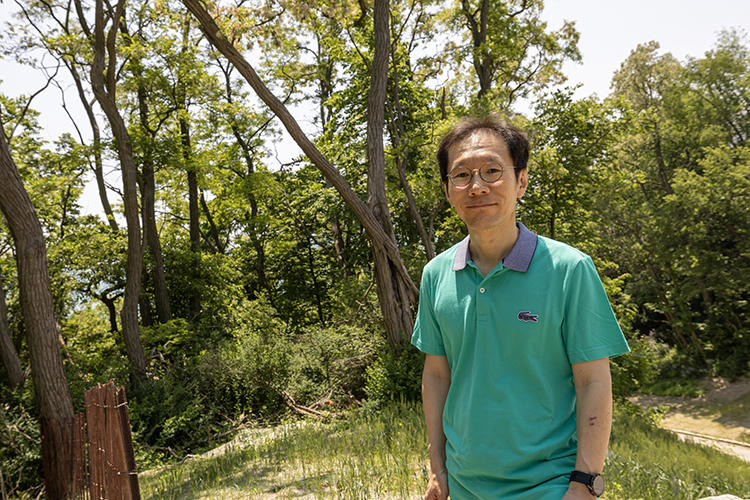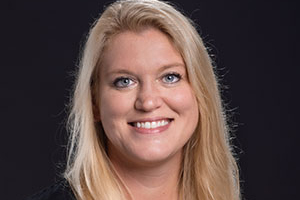Milwaukee temperatures climbed to a record 95 degrees over Labor Day weekend this year, while other parts of Wisconsin experienced drought conditions. Climate change is driving an increase in extreme heat waves in the U.S. and exacerbating droughts by making them more frequent and severe.
Woonsup Choi’s research has shown that urban expansion is associated with a more intense urban heat island effect in summer, including more exceptionally hot nights. In a study of 49 cities, including Milwaukee, he found that urban green areas are not increasing at the same rate as urban expansion – even when an urban population is declining.
An associate professor of geography, Choi is chiefly interested in how climate change, urban growth and drought affect the water levels in rivers and waterways.
In another research project, he and graduate student Susan Borchardt demonstrated that the recharging of aquifers, which provides the groundwater that replenishes rivers, will slow in the face of climate change in northeastern Wisconsin, despite an expected 5% increase in rainfall.
Choi recently sat down to talk about urban heat waves, the different kinds of drought (extreme lack of rainfall is only one kind) and the dual effect of climate change and groundwater withdrawal.
In one of your research papers, you looked at the association between land use and heat waves. Could you start by explaining what a heat island effect is?
In general, the Earth reflects some of the sun’s energy and also absorbs some of it. More specifically, the land surface receives energy from the sun during daytime and then stores part of it. The energy that the land accumulates during daytime is released at night and is largely responsible for the air temperature.
However, different materials on the ground have different abilities to retain that heat. Buildings and pavement not only release energy more slowly at night than soil does but also supply artificial heat. So nighttime temperatures there tend to be warmer compared to natural areas.
So, the warmer temperature in a city looks like an island surrounded by cooler temperatures. The mechanism of urban heat island is much more complex than this, and urban heat islands occur at particular atmospheric conditions.
Among the 49 cities you looked at in your study, you found an association between more extreme heat waves and a lack of green space. Tell us more.
In this study, we found that urban areas have increased rapidly, while green areas are declining in most of the cities we looked at.
I also conducted a study comparing heat island effects and temperature patterns in Milwaukee and Minneapolis. In Milwaukee, we are benefiting a lot from Lake Michigan, which has a very strong moderating effect on intense heat. But for both cities, the number of days and nights that exceed certain temperature thresholds has increased and is likely to increase in the future.
In addition to the background climate, the layout of the cities – features like whether it is more spread out, or dense with buildings – affect heat waves. Also, whether there’s a large waterway going through the city.
We can create conditions to lower heat island intensity if we can promote more air flow. More green space is important but also how the green spaces are connected to each other. If they are connected, the air can flow more freely.
Describe the different kinds of drought we experience in Wisconsin?
The meteorological drought happens when rainfall is lacking. In hydrological drought, the water in rivers and the amount of groundwater in aquifers is lacking. There is also agricultural drought, which generally means moisture in the soil that can be used by plants and trees is limited.
The water in rivers during a dry period usually comes from the groundwater. So, if the water is lacking in rivers, that can also suggest the water level is falling under the surface. But it’s not a simple correlation.
When meteorological drought happens, then naturally the water in the river will also decline – but not immediately. It will take some time.
Usually there is an association – or synchrony – that occurs when there is a meteorological drought. After some time, we can expect hydrological drought to result in falling river levels. And the same is true when it rains again or if it rains a lot: It takes a while to bring the river levels back. Land conditions also can affect the lag time between the two.
In another recent research paper, you investigated the characteristics of hydrological droughts in Wisconsin. What did you find?
In this paper, we looked at the location of 24 hydrological droughts during a 38-year period and found there were three areas across the state and each had different variables affecting drought conditions.
During the same time period, the number of high-capacity wells (used for agriculture), has increased substantially in Wisconsin.
We found that unlike meteorological droughts, hydrological droughts tend to occur more frequently in recent years and groundwater withdrawal from unconfined aquifers has exacerbated hydrological droughts. This has made it more difficult to predict hydrological droughts using information from meteorological drought.
What did you find in terms of hydrological drought in the Milwaukee area?
The water level in the Kinnickinnic River is extremely variable and, based on the method I used to diagnose hydrological drought, the results came out very different from other urban rivers. So, it needs further investigation.
The KK stood out because the watershed is highly urbanized. Generally, rainwater enters a river in two ways: Rain infiltrates the ground, and it stays there for a while before it exits into the river. At the same time, excess water that cannot infiltrate the soil will flow over surfaces and go directly into the river. When there is a lot of pavement, most of the rainwater will flow overground. So, the timing is short between rainfall and the rise in water levels.








